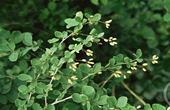Barbaris vulgaris

Slaboyadovit. Used parts: fruits, leaves, bark roots. Pharmacy name: fruits of barberry - Berberidis fructus( formerly: Fructus Berberidis), barberry leaves - Berberidis folium( formerly: Folia Berberidis), barberry root of barberry - Berberidis radicis cortex( formerly: Cortex Berberidis Radicis).
Botanical Description
Barbaris came to us from Africa through Spain. The spiny shrub is about 4 m in height. Young branches are red-brown, later dirty-gray. The leaves, partially modified into triple spines, are arranged in bundles. The underside of the leaves is often struck by a rust fungus, for which barberry is an intermediate host. From the axils of the leaves develop dangling racemose inflorescences of yellow flowers, from which, after fertilization, brilliant red elongated fruits develop. On the scrap of the stem or when cutting off the roots, it is seen that inside they are painted yellow. Blossoms in May-June. It occurs in hedges, in light forests, on sunny hills and mountain slopes.
Harvesting and harvesting of
In August-September, fruits are drowning, and they can be harvested. Usually they make juice, but sometimes they are left to dry. The leaves must be collected in June and immediately dried in the air. Bark from the roots are harvested in autumn. November( October) is the most suitable time for this. The excavated roots are cut, the bark is removed from them, threaded on threads and quickly dried in air.
Active ingredients
Fruits contain vitamin C, organic acids, besides they are rich in minerals and microelements. There are no alkaloids in mature fruits, so they can not be poisoned. But the leaves and especially the bark of the root are poisonous, since they contain many different alkaloids, for example berberine, oxyberberine, berbamin, yatorizin and others. In addition, there are tannins, resins and wax.
Therapeutic effect and application of
This medicinal raw material is not widely used in medicine, although, given its composition, we should expect more. Only sometimes tea is prescribed from the leaves and the cortex of roots with stagnant phenomena in the liver or, in general, with insufficient formation of bile, in the absence of appetite, and also in case of constipation, if it is caused by a small secretion of bile. Barbaris is also credited with a regulating effect on the heart. It is clear that with rheumatism try everything that could bring relief, because medicine is not yet able to treat this disease. Try and barberry, but success can be due to various reasons. This is also the opinion of the German State Health Service: if there is no reliable evaluation of the effect of the remedy, it can not be recommended for use. But here is a medicine from ripe barberry fruit worthy of recommendation. Juice or jelly from barberry is a wonderful refreshing addition to breakfast, it improves appetite in children with a reduced appetite. Who does not like too sour taste of berries, can mix them with sweet pears. This will improve the pungent taste of pears, and soften the acid barberry. Barberry juice, cooked with sugar, is considered a remedy to reduce nausea in pregnant women.- Barberry jelly: 500 g of ripe barberry berries cook lightly in a small amount of water, wipe through a sieve and cook with an equal amount of sugar. The resulting jelly is well stored and perfect for adding to others, especially sweet jellies.
Use in homeopathy
From the dried root bark prepare the original Berberis tincture( also called Berberis vulgarus unlike Berberis aquifolium from the American barberry).Tincture is used in breeding from D1 to D6 for biliary colic, cholecystitis, jaundice, hemorrhoids, kidney diseases accompanied by colic and bleeding, as well as with articular rheumatism. Take courses or if necessary 1-2 times for 3-10 drops. In homeopathic practice, barberry is more used for chronic cases.
Application in folk medicine
Everything that was said in the section "Curative effect and application", basically refers just to folk medicine. More often use tea from leaves( less often from the bark of the roots).The action is the same.- Tea from barberry: 1-2 teaspoons of raw materials( leaves or root bark) pour 1/4 l of boiling water and after 5 minutes strain.1-2 cups a day - ample dosage.
Side effects of
Fruits are free from alkaloids and are therefore safe, but in raw form they are sometimes poorly tolerated. Alkaloid-containing leaves and root bark can not be used without consulting a doctor. When an overdose can be observed loss of consciousness, vomiting, diarrhea, nasal and renal bleeding!
